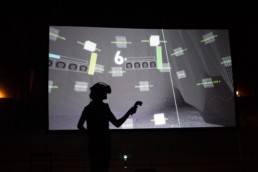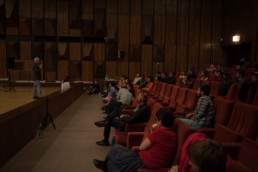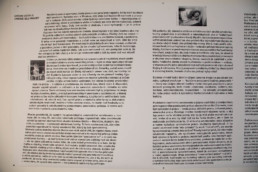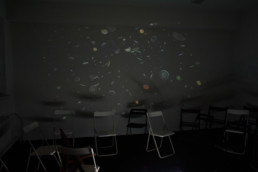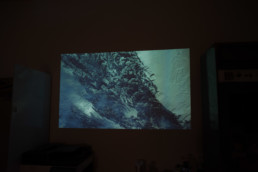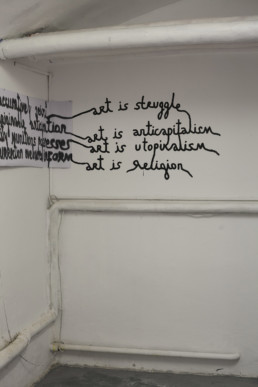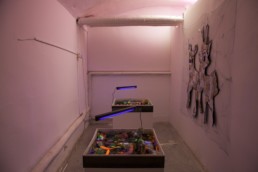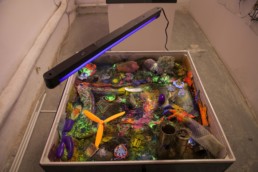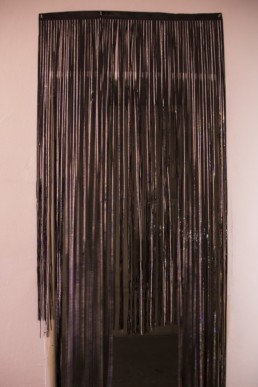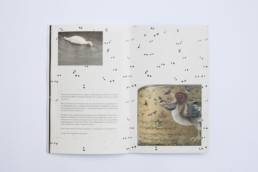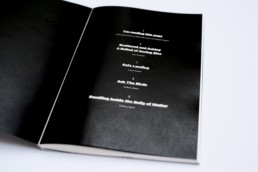Temporary connection with dancing plant
Otvorenie / Opening: 9 June, 2022 18:00
Perforwomance by Nela Pučeková 19:00
Výstava potrvá do 22 júna / Exhibition runs until 22 June, 2022
Temporary connection with dancing plant / Dočasné spojenie s tancujúcou rastlinou je skupinovou výstavou diplomantiek a diplomantov ateliérov APK+ a VVV z Katedry Intermédii Vysokej Školy Výtvarných Umení v Bratislave.
Názov výstavy Temporary connection with dancing plant vznikol kolážou vybraných slov z jednotlivých názvov vystavených prác. Toto intuitívne spojenie slov tak zastrešuje spoločnú výpoveď jednej generácie študentiek a študentov Katedry intermédií. To čo medzi nimi najviac rezonuje je téma tela vo vzťahu k technológiam a (alebo k) prírode a to z rôznych perspektív. Rovnako ako názov, tak aj jednotlivé práce vytvárajú akúsi koláž prístupov k tomu, čo sa nás ako ľudstvo bezprostredne dotýka – klimatická katastrofa, technológie a ich vplyv na naše telá, identity ale aj prírodu.
Práce študentiek a študentov reflektujú témy akými sú: hľadanie spirituálnych vzťahov technológii, človeka a prírody (Jakub Černošek); skúmanie hraníc našich tiel, ako ich dokážu rozširovať technologické protézy a ako hyperkonektivita prostredníctvom nich dokáže meniť naše “ja” (Patrícia Chamrazová); prepojenie ženského tela s prírodou, čarodejníctvom, zraneniami a tiež oslavou a obdivom rôznorodosti (Nela Pučeková); hľadanie rovnováhy v dobe rýchleho technologického vývoja (Vikoria Revická); preskúmavanie našej reality (Tsudoi Masuda) alebo aj virtuálnych svetov (Karolína Kožíková), či eskapizmus a útek do prírody, prítomné vnímanie krajiny v roli dočasného pustovníka (Ivan Kalev); otázky o tom čo znamená byť človekom, kde sú hranice človeka, kyborga, technológie, biológie, a ako uchopiť rozpadávajúcu sa predstavu o človeku ako vládcovi sveta (Ján Siman); podobne ako v románe Vegetariánka od Han Kang, uvažovanie o premene ľudského tela na rastlinu v časoch klimatickej katastrofy, kedy sa nová citlivosť k mimoľudským aktérom*aktérkam a planéte stáva nutnosťou (Paula Malinowska).
“Ak je príroda nespravodlivá, treba zmeniť prírodu!” Laboria Cuboniks
Peter Sit
Vystavujúce umelkyne a umelci / Exhibiting artists:
Jakub Černošek
Patrícia Chamrazová
Ivan Kalev
Karolína Kožíková
Paula Malinowska
Tsudoi Masuda
Nela Pučeková
Viktória Revická
Ján Siman
Vizuál / visuals: Dávid Koronczi
Program galérie z verejných zdrojov podporil Fond na podporu umenia / The gallery program is supported using public funding of Slovak Arts Council
9th Futurological Congress: Bratislava Chapter
(Gallery on the bottom of the post)
9th Futurological Congress, Bratislava Chapter
TALK TO ME! (The Future of Language)
Slovak Radio Building
Mýtna 1, Bratislava
22-23 September 2018, 15:00 – 20:00
TICKET SALE: https://tootoot.fm/sk/events/5b9e703a0a8f650a78225236
An upcoming iteration of The 9th Futurological Congress will take place in Bratislava on 22-23 September of this year, 2018. The congress has been invited to Bratislava by Apart, and it will be hosted at the auditorium of the Slovak Radio Building.
The main interest of the 9th Futurological Congress is to look at the future from several discrete perspectives, avoiding totalizing gestures or predictions – we are curious about the future, and we want to work on it… yet we don’t want to dictate what the future should be.
For the Bratislava iteration of the Futurological Congress, we are concerning ourselves with The Future of Language. Looking at it from the broadest perspective, language is many things: There is voice, there is text, there are musical notation systems… Language is communication. A way of communication is through words, but there is also the silence that helps give shape to those words. There is singing, there are stories passed around from voice to voice, there are misunderstandings, shibboleths, strange accents and mistranslations. There is the language of the body, and the means of communication used by those who are not able to speak. There are musical instruments, animal interactions in frequencies that are inaudible to the human ear, there is the cadence and lilt of poetry when it is being performed, and the difference from when it is only read on paper. There are bird mating calls, there is the low rumble of the earth, there are lexicons and idioms that belong to particular generations, and there are also lexicons and idioms that belong to specific political positions. There is the language of universalism, and there is also the terrible language that is spoken by the sound of war.
Julieta Aranda is one of the chairpeople of the 9th Futurological Congress. She is also an artist and editor of e-flux journal.
Peter Sit is a artist, curator, organizer and co-founder of APART
Participants :
Daniel Grúň
Body-Transmitters. Slovak Conceptual Art as Paranormal and Parainstitutional Activity.
Július Koller and Stano Filko are considered to be the founders of action and conceptual art in Czechoslovakia. However, a significant part of their lifelong work is difficult to grasp in the categories of Western art canon terminology. The relationship of both artists to non-artistic spheres, especially parapsychology, must be re-examined in order to understand the political dimension of their complex artistic worlds. Because there is an important synopsis of their engagement and effort to change thinking in relation to the world, society, and ultimately to ourselves and our own body. The lecture will focus on the futurological link of both artists in the wider context of Central and Eastern Europe. Based on a comparison of works and archives, I will try to indicate the relationship between paranormal and parainasational in their creation and the work of other artists generations.
Daniel Grúň is an art historian, curator, writer and art critic. Currently he works as an teacher in the Department of Theory and History of Art, Academy of Fine Arts and Design in Bratislava, and as a researcher of the Július Koller Society (since 2009). In 2010 he won the Igor Zabel Award for Culture and Theory.
Nicoline van Harskamp
PDGN
PDGN is a fiction video that portrays a future in which the world is no longer run by national governments or global corporations, and that is neither utopian nor dystopian. A new link language is developing between people across this world through voluntary self-instruction.
The script for PDGN was constructed from actually spoken, non-native English in a series of workshops. Some aspects of language and narrative were borrowed from feminist fiction that proposes systems of language-change, such as Marge Piercy’s Women on the Edge of Time (1976) and Suzette Haden Elgin’s Native Tongue (1984). The language of the script was further developed by applying common and expected factors of language evolution in the areas of syntax, lexicon, and phonetics. These ‘distorting factors’ were conceptualized with the help of academics in fields such as creole studies, computational linguistics and language acquisition as well as Esperantists, recreational language inventors, and the lead actresses Ariane Barnes, Mouna Albakry and Paula So Man Siu.
Nicoline van Harskamp is an artist whose recent works use and explore the English language that is created among non-native speakers worldwide, and imagine the (aesthetic) properties of a future spoken global language. She studied at the Royal Academy of Visual Arts (KABK), The Hague and the Chelsea College of Art and Design, London and was a resident at the Rijksakademie in Amsterdam. Van Harskamp currently teaches as a head tutor in Fine Arts at the Sandberg Institute, Amsterdam.
Karl Holmqvist
UNDERSTANDING IS OVERRATED
An artist’s presentation by Karl Holmqvist briefly outlining a visual arts practice that favours language over images. How rhythms and patterns in language and voice can access areas of hidden meanings and shared memory. The future lies in the powers of a collective imagination.
Karl Holmqvist is a poet and visual artist. In his publications, readings, collages, wall texts and installations he problematizes the text and the mutable potential of language as the bearer of meaning-content. He studied Literature and Linguistics at Stockholm University, Stockholm.
Boris Ondreička
Against Ontological Future
(in two chapters)
Through metaphores of Lurianic phenomenons of Tzimtzum and Shevirat ha-Kelim Ondreička tries to pseudo-speculate around the conflict between metaphysics of and ontology of time, biosemiotic sense of birth, life and processual death (decay as a source of unlimited creativity, in terms of Zalamean Transmodernismo) as means of possible political effect.
Boris Ondreička is a curator, artist, author and singer based in Bratislava, SK and Vienna, AT. He has been working as project coordinator at Soros centre for contemporary arts, Bratislava, SK, director of art–initiative tranzit.sk, Bratislava, SK, and since 2012 curator at Thyssen-Bornemisza Art Contemporary.
Ayumi Paul
WHY I BLUSHED
a lecture-performance
On thoughts about language, sound and ecology.
With music composed for a mountain drawing by Sophie Madeleine Jaillet, a 360 degree videoclip by Richard Reed Parry, a xylophon song for hermaphrodites, music from the 18th century for solo violin, a work by Yoko Ono, SEA WALKING composed by Elliott Sharp for Ayumi Paul and other findings.
Ayumi Paul is a Berlin-based violinist and composer. Her work combines site specific concert, composition, performance, and installation. The intrinsic sound of body, material, and the surroundings is essential to her conceptual approach to creating highly sensitive and often durational performances which expand the possibilities of listening. She trained as a classical violinist at Hochschule für Musik Hanns Eisler in Berlin and Indiana University and gave her solo debut at the Berlin Philharmonic Hall in 2003 from where she continued to perform at the world´s most sought after concert halls while at the same time developing her own distinct approach to music. In recent years she became more widely known in the visual and performative art context.
RADIO Espacio Estacion (RadioEE.net)
The Gezi Park Language
How is slang transmitted and sustained through codes and contradictions? What can fluid word formations tell us about how ideas immigrate? How does learning transform when it shifts from the grammars of schools to words of wisdom from the streets?
RADIO Espacio Estacion (RadioEE.net) is a mobile, multilingual, online radio channel broadcasting conversations about mobility and movement while on the move. It is led by a collective of artists, graphic designers, writers, and curators including Sebastian Bellver, Stephanie Sherman, Agustina Woodgate, and Hernan Woodgate.
Chaosdroid & Boris Vitázek
Language exercises for sonic spaces
(LESS) merges sound, visual and virtual reality in a playful exploration of spoken and unspoken language(s). The Futurological Congress iteration focuses on the distant future of human language, speculating on its practice solely as art. Language slams, A.I. opera and library index fugues are but a few of the possible manifestations into which our augmented and unfathomable descendants may indulge. Listen to your third ear.
Chaosdroid & Boris Vitázek
Amalia Roxana Filip (Chaosdroid) plays mostly with sound, live visuals and still images. She has been a member of various cultural initiatives, she participated as visual artist in festivals and exhibitions, and she played sounds in various clubs and cultural spaces – as herself or as part of multimedia projects. Few highlights: coordinator of a.live festival of live visuals, graphic designer for Kloaka literary magazine, co-author of the new media performance Skúmanie javov (Phenomena Research) and the transmedial project “liminal/lucent” (with Zuzana Husárová), erratic member of The Blackwood Incident sound project, VR researcher and mentor.
Boris Vitázek is an artist and designer, characterized by a combination of media and technology. His works include, for example, a theater combining elements of virtual reality with dance, or oversized projections based on sound and image generation in the form of mapping.
Tony Yanick
STO.RE, cultural practices of mnemonic immediacy
Sto.re (/stôrē/ pronounced story) is the ongoing research project into the problems of making sense of the complexity we face in the so-called hyperconnected era, specifically in terms of knowledge (and information) practices, attention, and general intellect. In terms of the future of language, I am interested in how sociotechnical systems condition new ways of reading and writing. Conveying knowledge through the audio-visual medium is becoming more and more the preferred method, yet we still lack the interfaces that enable us to acquire intimacy. The following will scrub the history of audio-visual technical memory and witness a new archival economy of memory emerging: the re:search and re:mixing of the the media archive. The future I explore is not the temporal indication of a future out there, rather to think of the future as an operator or a cut in the present. This spatial understanding of future (as a point, putting into relationship the fragments of information) poses not a speculative design, but rather reorients the question towards creating the spaces (virtual and actual) for these practices to emerge. What types of interfaces exist or could exist to access this future space? What sorts of collective intimacy emerges when practices of reading and writing, consuming and producing blur (where reading is writing)? To approach these questions, Sto.re explores transtextuality, the filmic-essay, hypermedia and distributed anarchives, and finally, machine learning and vision.
What can a (hyper)image do?
Tony Yanick is a philosopher, computer engineer, & multimedia artist from the United States. Currently, he is a PhD candidate at the University at Buffalo in the Media Study department.
The organizers reserves the right to make changes to the event program.
Organized by APART in cooperation with tranzit.sk
for more info contact us info@apart.sk
APART is a Slovak artist cooperative. Today, its members include Denis Kozerawski (* 1990), Peter Sit (* 1991), Magda Schery (* 1990), and Andrej Žabkay (* 1987). APART was formed at the turn of 2011 and 2012. APART performs research, creative-artistic, project- and exhibition- creative / curatorial, publishing, and archiving activities. The artists initiate, create, organize, and exhibit group manifestations (often giving space to other artists and theorists, as well), or work on their own. APART is a meta-participatory platform. It works on a proto-institutional basis, putting its polysubjectivity into directly related or desired contexts according to the principle of sharing economy.
tranzit.sk is a contemporary art initiative active in Bratislava since 2002. It is part of the international network tranzit.org, made up of similar organisations set up in Hungary, The Czech Republic, Romania and Austria which main partner is ERSTE Foundation. In the last five years tranzit.sk has focused on the relationship between art and society as well as on multidisciplinary approach. Its research-based exhibitions, lectures, discussions and workshops address a broad thematic spectrum, among others the heritage and culture of minorities, community and collective practices, the urban space, neighbourhood, the art system and the conditions of artistic production.
Supported using public funding by Slovak Arts Council, Erste Foundation, Július Koller Society and grant program of capital city of Bratislava – ARS Bratislavensis
Media partner: Kapitál
PROGRAM
Day 1: Saturday September 22nd 15:00 – 20:00
Doors open at 14:30 pm
3:00 – 3:15 Peter Sit – Introduction
3:15 – 3:30 Julieta Aranda. Introductory remarks
The 9th Futurological Congress : As a manner of speaking, Language beyond the spoken word.
3:30 – 4:00 radioee.net (remote conversation)
4:00 – 5:00 Radioee.net
The Language of Gezi Park
Live Broadcast
5:00 – 5:40 Daniel Grúň
Body-Transmitters. Slovak Conceptual Art as Paranormal and Parainstitutional Activity
5:40 – 6:00 20 MINUTE BREAK
6:00 – 6:30 Boris Ondreička
Against Ontological Future
6:30 – 7:30 Ayumi Paul
Why I Blushed
Lecture-performance
7:30 – 8:00 Q+A with all participants
Day 2: Sunday September 23rd 15:00 – 20:00
Doors open at 14:30 pm
3:00 – 3:15 Julieta Aranda
Introductory remarks to day 2
3:30 – 4:00 Tony Yanick
STO.RE, cultural practices of mnemonic immediacy
performative lecture
4:00 – 4:30 Nicoline van Harskamp
PDGN
screening and discussion
4:30 – 5:00 Karl Holmqvist
Understanding is Overrated
Performance
5:00 – 5:40 Chaosdroid & Boris Vitázek
Language Exercises for Sonic Spaces (LESS)
Audio-visual performance
6:00 Final remarks
ART IS WORK
ART IS WORK
curated by Apart collective
Krokus Gallery, Bratislava
15 Feb – 29 Mar 2018
Behind every exhibition opening, festival and biennale is hidden creativity and artistic labour. In the contemporary world of art and the global art market, a great deal of artistic labour remains unrecognized, eventhough the existence of the whole environment stands and falls on its tangible results. The exhibition Art Is Work aims to establish a discussion about the underfinanced cultural sector in the Slovak art scene, in particular about the lack of financial evaluation for artists and in adequate conditions for their work. Presented art works, planned lectures and debates in various forms ask questions about the value of artistic work, point to its precarization and its relation to capitalism, and its forms and transformations in (neo) liberal society. It seems,
that in order forthe system of unfair redistribution, in which we live today, to reproduce itself, certain “work” must disappear in order for another “work” to appear. Whether it is the work of a cultural employee or artist, wage worker or artistic installation, which is a result of artistic
labour. In spite of its necessity, we are not allowed to see certain”work” so that we do not see the malfunctioning of the system.
ART IS WORK v spolupráci s / in collaboration with: A2 kulturní čtrnáctideník, APART collective, Feministická (umělecká) instituce, Liam Gillick, Anetta Mona Chişa & Lucia Tkáčová, Jana Kapelová, Barbora Kleinhamplová, Bojana Kunst, Nulová mzda, Mohammad Salemy, Krisdy
Shindler, Jiří Skála, Tereza Stejskalová, Pavel Sterec, Raša Todosijević, Anton Vidokle, Working Artists and the Greater Economy (W.A.G.E.)
produkcia / production by Ema Hesterová, Katarína Neubelerová
architektúra / architecture by Andrej Žabkay
Ďakujeme / Thanks to: e-flux, Krokus Galéria, Miro Gajdoš, Martina Hajachová, Klaudia Kosziba, Maureen Paley, Andrej Sádecký, Lise Soskolne, tranzit.sk, laureáti Ceny Oskára Čepána 2017 – Katarína Hrušková, Nik Timková, Zuzana Žabková
publication
Reading of xenofeminist manifesto
There are no identities, only desires, interests, and identifications. Can radical queerfeminism be emancipatory politics for all? Let´s make gender- and class-divided society a thing of the past! Let´s use technology to overcome biological determinism! Let´s imagine reproduction outside families! Let´s reproduce the future! For bright tomorrows!
We invite you to a performative reading of the Xenofeminist manifesto with the screening of videos by Patricia Reed and Diann Bauer, members of the Laboria Cuboniks collective.
Laboria Cuboniks characterizes xenofeminism as an anti-naturalist, gender-abolitionist and techno-materialistic form of feminism. They want a future without patriarchal capitalism instead of identity politics. Everything for everyone. Against gender standards and for a different organization of reproduction.
Event is organized by Generácia Z with Apart collective
Reading will be held in the studio of APART collective in the Welding Research Institute.
Ján Ballx - A U T O G E N *
Ján Ballx x A U T O G E N *
3. August, 18:00
Výskumný ústav zváračský,
Račianska 1523/71 Bratislava
Počet účastníkov: max. 15, záväzná registrácia na info@apart.sk
Auto* označuje aj podstatu seba, identitu, autonómiu aj samostatnosť, sebestačnosť. Autogenéza je samovznikanie.
A autogénny tréning je psychoterapeutická metóda radená do relaxačno-koncentračných metód, ktorú vypracoval nemecký lekár – psychiater J.H. Schultz (1884-1970). Zvládnutie autogénneho tréningu učí účinne regenerovať psychickú a fyzickú energiu organizmu.
Pomocou audioreprodukcie ponúkame vo Zváračskom ústave (autogén je aj zváranie plameňom) možnosť experienciálne absolvovať jednu / piatu lekciu autogénneho tréningu.
Následne aj s využitím zážitkov z vegetatívnej relaxácie a embodied skúsenosti sa Ján Ballx pokúsi priblížiť experimentálne, experienciálne, synestetické poetické aj post-etické možnosti autorstva vo vzťahu k autorite v kontexte interpretačnej hypotézy Hefaistos (kováč/zvárač) komplexu, teda napríklad aj automatizácie, mechanizácie, technologizácie, metalurgie, alchýmie, podôb kooperácie, kompetície, manipulácie, kreativity a produktivity.
Nikhil Chopra - Drawing a Line through Landscape (Part 2: On the Road)
Drawing a Line through Landscape (Part 2: On the Road)
Nikhil Chopra has just completed his 60 hours long performance for documenta 14 in Athens. Enclosed in a shop on Archemedeous 15 he made drawings of the endless sea using mud and water as his medium. This was Part I of the durational performance “Drawing a Line through Landscape’.
After emerging from the muddy sea, Nikhil Chopra takes on Part 2 of the performance. This time he will make his way by road through Europe from Athens to Kassel from the 13th of May to the 8th of June 2017. He will pitch his mobile room in city squares, abandoned villages and the wilderness, stopping at each location to make drawings on the walls of his tent. Each location also presents it self with an original song that is sung to a prerecorded tune. Each location offers new collaborations with local and home-based artists.
Eventually Nikhil will end in Kassel on the platform of the old Hauptbahnhof with a series of large drawings that will be sewn together and draped to create one continuous panoramic drawing.
While searching for what we all have in common and art being a language that connects us all, the question that he is in search of is, “In the mode of a nomad, will performance realize its potential to transform; spaces, places, people and the self? The answer lies in the moment.”
Collaborations
Performance interventions in
-Sofia by Ivo Ivan
-Gorna Lipnitsa by Madhavi Gore and Jana Prepeluh
-Budapest by Ivan Angelus and Budapest Contemporary Dance Academy
Costume Design- Loise Braganza
Set Design- Aradhana Seth
Film- Sophie Winqvist
Song Writer- Gautam Sharma
Music- Ranjit Arapurkal
Driver- Stephen Frick
Documentation- Madhavi Gore
Project Assistant- Shaira Sequeira
Project commissioned by documenta 14 and supported by Piramal Art Foundation, Payal, and Anurag Khanna, Galleria Continua and Chatterjee & Lal
Project Partners – University of Ioannina, Department of Fine Art; Tsarino Foundation; Sofia Underground Performance Art Festival; Atelie Plastelin, Sofia; Old School Art Residency, Gorna Lipnitsa; Tancskola, Budapest; Bridgeguard Residency, Sturovo; Apart Collective, Bratislava.
http://www.documenta14.de/en/calendar/20709/drawing-a-line-through-landscape-part-2-on-the-road
Babi Badalov - Electronic Dadaist Poetry
Hviezdoslavovo nám. 18, Bratislava (backyard of AFAD)
The concept of Babi Badalov´s exhibition comes from his personal need to resist the current state of affairs. For the exhibition at gallery HIT, Babi decided to work with technology of predictive writing. He understands this technology as a dadaist negation of the present time. The integral part of the opening will be a performance, which will create a connection between predictive writing and the author himself.
The essential material of Babi’s work is language. He is interested in its limits, its ability to isolate the individual from the rest of the society. Through the medium of language, he is contemplating current geo-political situation, relating it to his personal experiences. His migration through countries of former Soviet Union, the United States of America, Europe, Asia and the Middle East are preserved in his drawings, collages and ornamental poetry, in which cultural, historical and ideological overlapping of our globalized world can be seen and read.
Babi Badalov, born in Lerik ( Azerbaijan), lives and works in Paris. He exhibitied for example at Tensta Konsthall (Sweden), MUSAC – Museum of Contemporary Art (Spain), Palais de Tokyo (France), Kunstraum Munich (Germany), The Museum of Contemporary Art, Krakow (Poland), Kunstmuseum Bern (Switzerland), Tranzitdisplay (Czech republic), Erarta Museum of Contemporary Art, St. Petersburg (Russia), New Museum, New York (USA), Museum of Contemporary Art Antwerp (Belgium), MANIFESTA 8, 11th Gwangju Biennale, 6th Moscow Biennale, 15 th Jakarta Biennale, 54 th Venice Biennale, 4th International Baku Biennale.
What is a human being is if he is not a citizen? What are his rights at the moment in which it is not possible to characterize them as rights of a citizen of state ?
Human rights. Fiction. Our hallucination. The world found itself in ruins of human rights the moment it faced a man who lost everything else except for the pure fact of being a man.
We perceive the rules of language and Declaration of Rights from 1789 as immutable meta-rules and values, which bound us to respect them instead of thinking about them in a context of our present days towards a better future in order to reflect our modern world in relation to our needs.
Mladen Stilinović told us more than 20 years ago : AN ARTIST WHO CANNOT SPEAK ENGLISH IS NO ARTIST. Today we could add : AN ARTIST, A CURATOR, A GALLERY INTERN WHO CANNOT SPEAK ENGLISH IS NO ARTIST, NO CURATOR, NO GALLERY INTERN.
If in the contemporary world an artist who doesn’t speak English is not an artist and if a man who is not a citizen, doesn’t want to be or can’t be naturalized or sent back to his homeland, lost all his rights and doesn’t want to conform to the new national identity is not a human being, then who is Babi Badalov ?
Anomaly
Deviation
Divergency
Azimuth
Human
Future
Some people wish he was, as Babi Badalov writes, just their „hallucination“.
In the situationist dictionary, Mustapha Khayati writes that the language is the house of power, the refuge of its violence. If the political power restrains from using physical violence, it relies on language to guide its order. Each new interpretation authorities call misinterpretation and dictionary is the guardian of meaning.
For situationists, the critique of predominant language became permanent new revolutionary theory.
Babi Badalov is a poet, an artist, which disposes language of its status of exclusive commodity and turns it to a gift, to a theft, to an excrement, to waste. Using exclusively found objects on which he notes down his orna-mental poetry, he disposes language of its aura of holiness and glorification.
By means of his visual poetry, he creates a language, which is not an objective reflection of the present times, but which tries to speak the truth to its power. He is an intellectual. A person, who works from exile, from periphery, marginally. He is not a professional in the selected field, but rather an uninvited „outsider“, who unlike an „insider“, does not follow his individual interests, who breaks the limits of human thinking. He is powered by a belief that nothing is given that there is not only one truth and everything is allowed.
He is a prisoner of language and at the same time the only one who can see its bars and is challenged by its totalitarian order on a daily basis.
Contemporary art world is the world translated to English.
As the status of a refugee is always considered a temporary state, which leads either to naturalization or repatriation likewise is the non-acquaintance of English language deemed temporary.
In his status of a refugee, Babi Badalov calls into question the unity of holy trinity of state/ nation/ territory and touches what nation considers its own – its language. He is a thief of a language. If all departures from the normative/ totalitarian/ hegemonial/ official grammar are its deviation, then he makes the language deviated.
Giorgio Agamben wrote that refugee is breaking up the identity between man and citizen, between nativity and nationality. By his existence he threatens the basis of national states, in which limitations growing number of people can no longer be represented and casts doubt on the original illusion of their sovereignty.
As International Art English, defined as an amateurish English used in art press releases, is a space of conflict, fight and controversy, diversion of language and doubting of its sovereignty so is the category of a refugee the one through which we can perceive forms and limitations of future political community.
International Art English, which has become a sort of universal language of communication between artists, curators, institutions and international public and without its knowledge it became almost impossible to create, which has the potential to unite people and alienate them at the same time, is the house of power, a tool of oppression and exploitation.
By means of his short disruptive impulses in the authoritative world of grammar and inviolability of language syntax he outlines future publics outside of our territorial and class models.
For this exhibition he will find himself in a dialogue with software. As a sustainer of Dadaist tradition, he applies principles of dada creation to the technology of predictive writing. The language, with which the algorithm of predictive writing manipulates, is based on the ability to predict what his user will say next, based on what has been previously inserted into it. He is aware of the dominance of English language, which has always been the tool of the empire and whose spreading is currently accelerated by technological progress. However, he does not radically rejects its dominance nor does he negate it, but he understands it as an offering of the room for confrontation, a space where he can insert absurdity into otherwise rational algorithm.
Contrary to the software, Babi Badalov is not trying to find a logical system in absurdity, but he allows himself to stay in chaos, in not-knowing and admits the impossibility of predicting the contingency and creative thinking. He is not trying to find recourses. For this exhibition, in terms of his performance, he finds himself in a dialogue with software. In a dialogue, in which human and machine don’t understand each other, because they can not (not yet).
Kristína Országhová
Mehraneh Atashi - Safe Landing
Opening + Book launch
November 18, 2016 7pm
HIT Gallery
Hviezdoslavovo námestie 18, Bratislava
The exhibition continues until December 6th 2016
Opening hours: Tue – Thu 3pm – 6pm
The exhibithion is prolonged till 13 Dec – The ame day will be finissage & curatorial guided tour – 6pm
APART collective has for the first time encountered with the work of Mehraneh Atashi at the group exhibition DUST in Ujazdowski Castle in Warsaw. Her work Entropy Pump (2013) struck their attention. Earlier this year members of APART visited Mehraneh in Amsterdam and then agreed on common project for The HIT Gallery in Bratislava. The work of the artist were premiered in Slovakia in June as a part of an international project Forming of Inevitable Blue, curated by the APART collective.
Process of transformation is central to Atashi’s practice, whereas the reactions in between the different materials, seemingly irreconcilable in their nature, create a connection. Atashi’s landscapes are in resistance, she says, they provide the conceptual ground for addressing the native, ecological and environmental complexities in relation to energy, memory and transformation – whereas the landscape can be thought both in a micro and macro dimension. The self becomes a material in these landscapes, it is a found object which can be amplified, modified and documented. Atashi creates complex sign systems, in an endeavour to form the reality and change the past. Atashi’s sign systems may require more than our full attention to be deciphered, as magic is forming and reforming reality.
Along with the exhibition Safe Landing APART prepared together with a team of curators Laura Amann, Frederica Bueti and Sara Giannini a profile publication of the artist. In addition to the curatorial texts the publications also contains a contribution of a Slovak visual artist Martin Vongrej, a common textual-visual conversation with Mehnrahe Atashi. Safe Landing is the first solo exhibition of Mehraneh Atashi in Slovakia and Eastern Europe.
Mehraneh Atashi was born in 1980 in Tehran and is currently living in Amsterdam, where she was a resident at the Rijksakademie in 2013/14. Her work was presented in several gallery and museum exhibitions, including at the Galerie Gabriel Rolt, Amsterdam (2016),Luckman Gallery, California State University, Los Angeles (2016), Triumph gallery, Moscow (2016), Centre for Contemporary Art at Ujazdowski Castle, Warsaw (2015) Victoria & Albert Museum, London (2012), the Musee du Quai Branly, Paris (2009/2007) and in other exhibithions and venues.
APART @ HIT GALLERY
www.itsjustdelusionoftouch.com
thanks to: Laura Amann, Martin Vongrej, Sara Giannini
poster: Ondrej Jób
Supported using public funding by Slovak Arts Council, & Europapier.
BOOK: Mehraneh Atashi
Anton Vidokle & Arseny Zhilyaev - Art Without Death: Russian Cosmism
Anton Vidokle and Arseny Zhilyaev – Art Without Death: Russian Cosmism
13th April 2017, 5pm, Kunsthalle Bratislava, lecture and screening
Lecture is organized by APART in collaboration with SOFT NORM (AFAD) project and Kunsthalle Bratislava. Lecture will be realised in the framework of the exhibition – APART: Possibility of preserving
Arseny Zhilyaev’s lecture titled And Apple Trees Will Bloom On Mars will introduce the origin of Russian Cosmism, its main trajectories and representatives that include philosophers, scientists and thinkers. Anton Vidokle will screen two films from his trilogy on Russian Cosmism (the third will be premiered at HKW, Berlin in the fall) including This is Cosmos (2014) and The Communist Revolution Was Caused By The Sun (2015). A Q&A will follow the presentations.
“The cosmism movement, which called for material immortality and resurrection, as well as travel to outer space, developed from a particular spirituality in nineteenth century Russia. The doctrine of immortal life in infinite space captured the optimism of science and the arts in those days. Since then, the utopian, science fiction-like thinking of the cosmists had a great influence on art, science, and politics in both pre-revolutionary and Soviet Russia.
Looking at it today, cosmism – although overshadowed by official Soviet ideology – opens up new perspectives on the Russian avant-garde as well as the ideology and politics of present day Russia. For example, in his influential writings, Nikolai Fyodorov (1829-1903) demanded that the ultimate goal of technology must be to overcome death; all people who had ever lived on earth must be brought back to life. The cosmists were also visionary pioneers of space travel. Fyodorov, for instance, claimed that the colonization of other planets would be the inevitable consequence of the lack of space after the resurrection of the dead. The institution of the museum also played a central role in cosmism as the material needed for the resurrection of individuals would have to be preserved there. Nikolai Fyodorov, like the painter and founder of Suprematism, Kazmir Malevich, believed that after the death of God, the museum would be the only place where a transhistorical union beyond the grave would be possible.”
Excerpt from an annotation of the upcoming exhibition at HKW Berlin “Art Without Death: Russian Cosmism,” organized by Anton Vidokle, Arseny Zhilyaev and Boris Groys, September 2017:
https://www.hkw.de/art_without_death_russian_cosmism
Anton Vidokle is an artist living and working in New York and Berlin. As founder as e-flux, and co-editor of e-flux journal along with Julieta Aranda and Brian Kuan Wood, Vidokle has presented projects internationally including at the Venice Biennale (2015) and Documenta 13. Most recently, Vidokle has presented his films at the Berlinale International Film Festival (2015, 2016), the Moscow Biennial (2016), the Gwangju Biennial (2016); amongst others.
Arseny Zhilyaev explores the heritage of Soviet museology in his artworks from a revisionist perspective. Since 2011 he is a co-editor of Moscow based magazine about art Khudozhestvennyi Zhurnal. His work has been exhibited internationally at Liverpool Biennale (2016), Ljubljana Triennial (2016) and Tretyakov State Gallery in Moscow (2012); amongst others.
Hedwig Saxenhuber - Rocket Launch and Reflections on The School of Kyiv
Lecture, screening, discussion
13.09.2016, 5:30 pm – 7:45 pm
Kino Mladosť, Hviezdoslavovo námestie 171/17, 811 02 Bratislava
The lecture and discussion will be held in English. Screening Zlaté Piesky Rocket Launch, 2015, 10 min
The old tranzit.sk studios are starring in the film Zlaté Piesky Rocket Launch, Josef Dabernig’s contribution to The School of Kyiv, Kyiv Biennial (2015). tranzit.sk presents this movie and its author in an evening debate on the Biennial that has taken place in Kyiv and cities around Europe since last year when Ukraine was at war with Russia and suffering from an economic crisis and social insecurity, a time that seemingly had other priorities than an international art event. Yet, The School of Kyiv imagined proposing alternative pictures of history and currents and other futures for the place. In this way, it hoped that the agora it set up could help to suspend the opposition between aesthetics and politics, between the politics of memory and remembering, between the real and the imaginary, oscillating between even antagonistic realms.
Hedwig Saxenhuber, co-curator of The School of Kyiv, Josef Dabernig and Boris Ondreička will talk about Zlaté Piesky Rocket Launch and reflect on the conditions of curating during this complex period while reconsidering the notion of “the uses of art.”
_____
Hedwig Saxenhuber is a curator and co-editor of springerin Hefte für Gegenwartskunst, Vienna. From 2005 to 2015 she was program director with Christian Kravagna at Kunstraum Lakeside in Klagenfurt. Her recent large-scale projects include The School of Kyiv, Kyiv Biennial 2015, Unrest of Form – Imagining the Political Subject (with Georg Schöllhammer and Stefanie Carp, Vienna Festival, MQ, 2013); Bad Script for a Retrospective, Josef Dabernig (P74, Ljubljana 2011) Bertha von Suttner Revisited, (Schloss Harmannsdorf, with Susanne Neuburger, 2009); Ladies Almanach, (tranzit.cz, Prague, 2009); Art + Politics, from the Collection of the City of Vienna (MUSA, Vienna 2008); Gyumri Biennial, Armenia, 2008; VALIE EXPORT (Moscow Bienal, NCCA, 2007). She is an associate member of the Vienna Secession.
Josef Dabernig is a visual artist and filmmaker based in Vienna. He graduated with a degree in sculpture from the Academy of Fine Arts Vienna in 1981, before extending his artistic practice to film, photography, text and questions of architectural display. His work has been exhibited at the Manifesta in Ljubljana and St. Petersburg (2000 and 2014), the Venice Biennial (2001 and 2003), the Gwangju Biennial (2012) and the Kyiv Biennial (2015), while his film festival presence includes Rotterdam, Toronto, Venice and an Oberhausen Profile this year. Dabernig’s recent and upcoming solo exhibitions include Kunsthaus/Neue Galerie in Graz (2013), tranzit workshops, Bratislava (2013), MOCAK, Krakow (2013), mumok Vienna (2014), Galerie Andreas Huber, Vienna (2014), Wilfried Lentz, Rotterdam (2015), P74 Gallery, Ljubljana (2015), Lulu, Mexico City (2016), Kunsthalle Winterthur (2016) and the Badischer Kunstverein, Karlsruhe (2017).
Boris Ondreička is a curator, artist, author and singer based in Bratislava and Vienna. He was project coordinator at the Soros Centre for Contemporary Arts, Bratislava, director of tranzit.sk, Bratislava, and since 2012 he has served as a curator at Thyssen-Bornemisza Art Contemporary, Vienna, where he co-curated Rare Earth, Supper Club, Tomorrow Morning Line, Ephemeropteræ (since 2012) and recently Olafur Eliasson Green Light—An Artistic Workshop. Among others, he co-curated Manifesta 8 in Murcia and Cartagena. In 2010, he co-founded the Julius Koller Society. His artistic projects were presented at Manifesta 2, Biennials in Luxembourg, Venice (Czecho-slovak & Roma pavilions), Prague, Gyumri, Torino, Anzengruber, Tai-Pei, Athens, Kyiv and Jakarta, MoMA-PS1 New York, BAK Utrecht and many others. His HI! lo was published at tranzit/jrp Ringier and One Second/Out of Time at Revolver. Since 1987 he has been the lead-singer and lyricist of the Bratislava band, Kosa z nosa.
The event is organized by tranzit.sk in collaboration with APART.
Erste Foundation is main partner of tranzit.






